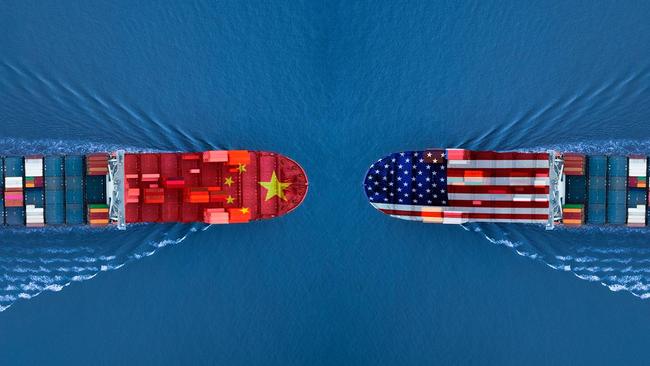Monsters of Rock: The risks Goldman sees for commodity demand and Rio flexes its muscles
Tariffs on Chinese goods could bring risks for commodity demand, as Goldman Sachs warns on iron ore, coal and alumina.

Stockhead
Don't miss out on the headlines from Stockhead. Followed categories will be added to My News.
Goldman Sachs analysts say China could reduce metal consumption in response to Trump tariffs
But it remains buy rated on cashed-up large-cap miners
Rio Tinto flexes M&A muscle in uranium and iron ore
For most of us China is a black box, with little certainty how policy shifts will transform its commodity demand impulse, all important for a market like Australia.
The imposition of major tariffs across the world by Donald Trump this week roiled markets, then lifted them up as only a 125% tariff on China and base rate of 10% on the rest of the world remained in a face-saving turnaround after US bond yields soared.
With China counting as the dominant manufacturing power in the world, and its key commodity demand centre, how could tariffs impact the global metals market?
It's a question Aussie mining analysts at Goldman Sachs, led by Paul Young, have been asking steel mills and manufacturers in a recent sojourn to Beijing and surrounds.
"The impact of tariffs on commodity demand is uncertain, but we expect some level of inventory chain destocking and a reduction in metal consumption over the next 6 months and therefore a negative impact on commodity prices to a certain degree," they said.
"Notably, Chinese steel mills and manufacturing companies we met with on our recent China M&M trip expressed concern to us about the impact to demand and exports from US tariffs."
Goldman Sachs has already gone a tad more bearish on iron ore.
An update last month showed the US investment bank saw prices – US$96.50/t today – dropping to US$85/t by the fourth quarter, with the potential to briefly breach US$80/t.
Since the Brumadinho disaster in early 2019 the commodity has largely rebounded each time it's threatened to break through US$90/t, with higher cost marginal suppliers picking up the slack from the Brazilian major Vale.
New supply out of Africa could threaten that equilibrium with the Simandou mine in Guinea expected to ship first ore later this year. Fortescue's (ASX:FMG) Andrew Forrest sounded the alarm over the threat to Australian iron ore from higher grade deposits in Africa this week at a leadership breakfast where he pitched for funding for green iron plants in Oz.
Cuts
Among the questions posed by Goldman were what will happen with steel production in China this year, a key factor in propping up iron ore prices.
"The six steel mills we visited in Tangshan on our China M&M trip believe that any Chinese steel production cuts are likely to be modest and occur in 2H." Inconclusive then.
Goldman has downgraded its coal and alumina forecasts, as well as zinc and lead prices.
But it remains buy rated on key large caps BHP (ASX:BHP), Rio Tinto (ASX:RIO) and South32 (ASX:S32), seeing resilient free cash flow and strong balance sheets across the majors, as well as steelmaker Bluescope Steel (ASX:BSL).
The key changes for resources investors in Goldman's coverage this week came at Sandfire Resources (ASX:SFR) and Mineral Resources (ASX:MIN).
GS cut its price target on copper miner Sandfire from $10.40 to $10.20/sh, but lifted its valuation to a buy on the bank's "positive long run view on copper despite expected volatility near term, and strong FCF and deleveraging, trading on >10% FCF yield from 2025-2027, and forecast to be net cash by end of FY26 on our estimates."
MinRes, meanwhile, copped a hit on its gearing, with GS lopping its PT from $30 to $18 and sticking a sell rating on the iron ore and lithium miner, whose beleaguered boss Chris Ellison insisted would turn the corner in a message to staff this week.
"MIN continues to be highly geared, and we forecast net debt to further increase across FY25/26," Young et al said.
There were downgrades to neutral for Whitehaven Coal (ASX:WHC), Coronado Global Resources (ASX:CRN) and Deterra Royalties (ASX:DRR) on lower coal and iron ore prices, while FMG was upgraded from sell to neutral after a sell off that saw its valuation drop to 0.8x NAV.
"...although we expect FCF to compress over 2025 in-line with our lower iron ore price forecasts. The company does have levers it can pull on opex and capex if required," GS's number crunchers said.
Big dog in the yard
Rio Tinto, meanwhile, looks to have pulled off a one-two M&A punch, flexing its muscle as it entered compulsory acquisition of uranium stock Energy Resources of Australia (ASX:ERA) and became the preferred bidder for CZR Resources' (ASX:CZR) Robe Mesa iron ore deposit.
The ERA acquisition will enable Rio to take full control of rehabilitation at the Ranger uranium mine, where it has pledged to return the project to the state of the surrounding Kakadu national park.
It came after a squabble with minority investors, who wanted the company to either develop the untapped Jabiluka deposit or sell it to a company incentivised to do so. A dilutive capital raising last year saw Rio grab a more than 98% share in its subsidiary.
Jabiluka has stayed dormant for years due to a veto from traditional owners. ERA launched legal action last year against a NT government decision not to renew its lease at the site.
Rio's Robe River JV, in which it holds a 53% stake, has meanwhile delivered a binding proposal to acquire the Robe Mesa project for $75m.
Robe River, which counts Japanese companies Mitsui (33%) and Nippon Steel (14%) as its minority holders, supplies a product valued by Japanese carmakers for its low phos content.
CZR has now received a binding offer from a collective of companies owned by Rio and Mitsui to buy its 85% stake for cash.
The deal has the approval of majority shareholder Mark Creasy, the billionaire prospector who also plans to sell the minority stake held by his private company Zanthus Resources to the bidders.
CZR had previously agreed to a merger with Fenix Resources (ASX:FEX), a junior iron ore miner based out of WA's Mid West, which would have acquired CZR's shares for scrip.
The Robe Mesa site has been the subject of feverish M&A activity over the past two years, with a prolonged Foreign Investment Review Board approval process leading to the cancellation of a $102m deal to sell the project to China-backed Miracle Iron.
CZR has until 8pm WA time on Thursday to accept the proposal, which it has declared superior the 0.85 for 1 share offer from Fenix, which has matching rights.
The ASX 300 Metals and Mining index fell 2.15% over the past week.
Which ASX 300 Resources stocks have impressed and depressed?
Making gains
De Grey Mining (ASX:DEG) (gold) +16.1%
Northern Star Resources (ASX:NST) (gold) +15%
Capricorn Metals (ASX:CMM) (gold) +14.8%
Regis Resources (ASX:RRL) (gold) +14%
Eating losses
Mineral Resources (ASX:MIN) (lithium/iron ore) -23.9%
Coronado Global Resources (ASX:CRN) (coal) -20.3%
Alcoa Corporation (ASX:AAI) (alumina) -19.4%
WA1 Resources (ASX:WA1) (niobium) -19.2%
Gold stocks salvaged what would otherwise have been a rotten week for the ASX 300 Mining and Metals index, as prices hit fresh highs in excess of US$3200/oz.
The precious metal has acted as the go-to safe haven for investors as bonds and equities flopped in the wake of Donald Trump's tariff-led market selldown.
Originally published as Monsters of Rock: The risks Goldman sees for commodity demand and Rio flexes its muscles


